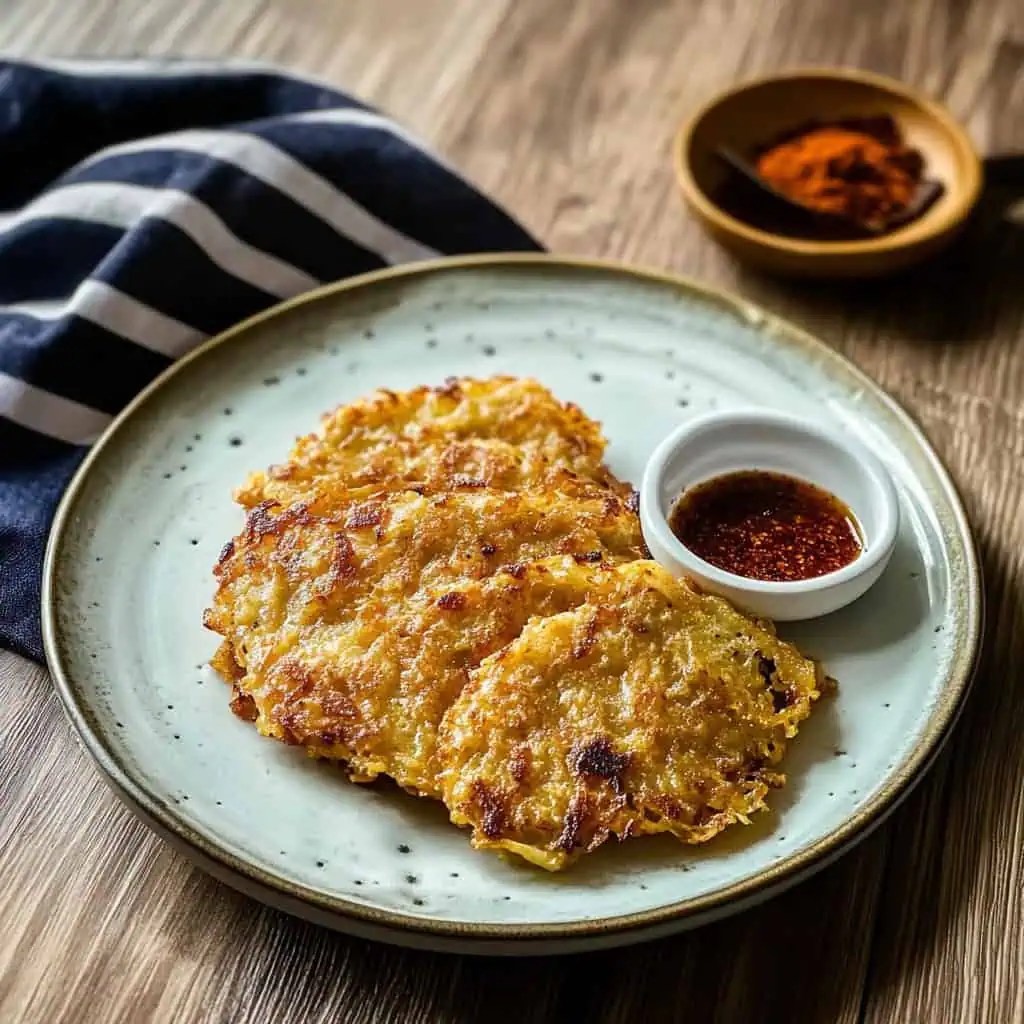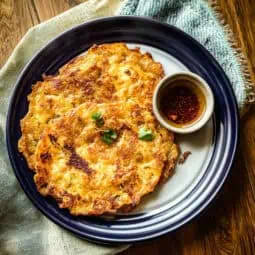Some of my fondest memories revolve around my Tito Greg's small karinderia (local eatery) in Tondo. I would watch him prepare his famous Tortang Dulong, a dish that would consistently sell out before the morning rush ended.
He taught me that the secret wasn't just in the ingredients, but in understanding the delicate balance of temperature and timing. What made his version special was how he achieved that perfect golden-brown crust while keeping the inside tender, a technique that took him years to master.
Today, while dulong has become more of a premium ingredient, especially outside the Philippines, the technique my Tito Greg taught me remains unchanged. This recipe is my tribute to him and the countless early mornings he spent teaching me that even the simplest dishes can bring the greatest joy when made with patience and care.
Jump to:

Why You'll Love This Recipe
This classic Filipino dish perfectly balances simplicity with remarkable flavor. The delicate silverfish creates a uniquely textured omelette with crispy edges and a tender center. It's an excellent source of protein and omega-3 fatty acids, making it both delicious and nutritious.
Ingredients
The ingredients in Tortang Dulong create a perfect balance of texture and flavor. Fresh silverfish provides a delicate seafood taste and valuable protein, while eggs act as the essential binder that holds everything together.
All-purpose flour and cornstarch work as thickening agents, creating that signature crispy exterior while helping the mixture stay intact during cooking. The combination creates the ideal contrast between the crunchy golden outside and tender, flavorful inside that makes this dish so beloved.
Salt and pepper enhance the natural flavors without overpowering the delicate taste of the silverfish, letting the star ingredient truly shine.

- 250g dulong/silverfish, washed and drained
- 2 large eggs, lightly beaten
- 1 tablespoon all-purpose flour
- 2 teaspoons cornstarch
- Salt to taste
- Freshly ground black pepper to taste
- Cooking oil for frying
Equipment
- Non-stick pan (kawali): Essential for achieving crispy edges without sticking. The flat surface allows for even heat distribution.
- Medium mixing bowl: For thoroughly combining all ingredients before cooking.
- Measuring spoons: Ensures precise portions for consistent results.
- Spatula: Wide-edged spatula helps flip the delicate omelette without breaking.
- Fine-mesh strainer: Critical for properly washing and draining the tiny silverfish.
- Paper towels: Removes excess moisture from the fish, which is key to achieving crispiness.

How To Make
- Set your stove to medium heat (190°C/375°F) and gather all your ingredients and equipment on the counter.
- Wash the dulong (silverfish) in cold water using a fine-mesh strainer. Drain well and pat dry with paper towels. This removes excess moisture and helps achieve crispy edges.
- Break two room-temperature eggs into a medium mixing bowl and beat them lightly until yolks and whites combine.
- Add one tablespoon of flour and two teaspoons of cornstarch to your beaten eggs. Whisk until smooth with no lumps.
- Gently fold your dried dulong into the egg mixture. Be gentle to avoid breaking the delicate fish. Season with salt and black pepper to taste.
- Let this mixture rest for 5 minutes - this helps the flour hydrate properly and improves binding.
- Heat two tablespoons of oil in your non-stick pan. You'll know it's ready when the oil shimmers but isn't smoking.
- Using a ⅓ cup measure, carefully pour portions of your mixture into the hot pan. Keep about 2 inches space between each portion if cooking multiple pieces.
- Cook for 3-4 minutes until the bottom turns golden brown and edges become crispy.
- Flip each piece carefully using a wide spatula. Cook another 2-3 minutes until both sides are golden brown.
- Place your cooked torta on a paper-towel-lined plate to remove extra oil.
- Serve immediately while hot with steaming white rice and your choice of dipping sauce - either spiced vinegar or sweet chili sauce.
Note: For the best results, use fresh oil for each new batch, and wipe your pan clean between batches if needed. The perfect Tortang Dulong should be golden brown outside, moist inside, with crispy lacy edges and easily cut with a fork.

Tips from Lola's Kitchen
- Drying is crucial: Pat the silverfish thoroughly dry with paper towels – this is the secret to achieving maximum crispiness.
- Temperature matters: Room temperature eggs create a better binding mixture than cold ones.
- The resting secret: Let the mixture rest for 5-7 minutes before cooking to allow the flour to fully hydrate.
- Oil temperature test: Drop a tiny bit of the mixture in the pan – if it sizzles immediately, your oil is ready.
- Batch cooking: Never overcrowd the pan – cook in smaller batches for the crispiest results.
- The flip technique: Slide your spatula completely under the omelette and flip in one confident motion.
- Consistent heat: Maintain medium heat throughout cooking for even browning.
Substitutions
- Silverfish/Dulong: Small anchovies (dilis) or whitebait work well. If unavailable, tiny shrimp can be used but will change the flavor profile.
- Cornstarch: Potato starch or tapioca starch provides similar binding properties.
- All-purpose flour: Rice flour creates an even crispier exterior and makes the dish gluten-free.
- Eggs: While not traditional, egg substitutes can work for those with allergies, though texture will differ.
- Cooking oil: Coconut oil adds a subtle Filipino flavor enhancement.
Troubleshooting
- Omelette falls apart when flipping: The mixture might be too wet. Add an extra teaspoon of flour to improve binding or dry your silverfish more thoroughly.
- Not crispy enough: Your oil wasn't hot enough before adding the mixture. Ensure it shimmers before cooking.
- Burning too quickly: Your heat is too high. Lower to medium-low and allow for slower, more even cooking.
- Eggy taste is too strong: Add more silverfish to the mixture or reduce to just one egg.
- Too salty: Dulong can have varying saltiness. Taste the mixture before adding salt and adjust accordingly.
- Sticking to the pan: Your pan isn't non-stick enough. Add a bit more oil or use a better quality non-stick pan.
Storage & Reheating
- Refrigeration: Store in an airtight container for up to 2 days. Place parchment paper between layers to prevent sticking.
- Reheating in pan: The best method is to reheat in a non-stick pan over medium heat for 2-3 minutes per side until hot and crispy again.
- Reheating in oven: Place on a baking sheet at 350°F (175°C) for 5-7 minutes to restore crispiness.
- Microwave (emergency only): 30 seconds on medium power, though this will make the exterior soft.
- Not recommended for freezing: The texture significantly deteriorates when frozen and thawed.

FAQ
Why is my dulong mixture too watery?
Fresh dulong naturally contains a lot of moisture. Pat them extremely dry with paper towels and let the mixture rest before cooking to allow the flour to absorb excess moisture.
How do I know if dulong is fresh?
Fresh dulong should be translucent, have a mild sea scent, and the eyes should be clear, not cloudy. They spoil quickly, so use within 24 hours of purchase.
Can I make this ahead for a party?
While best served fresh, you can prepare them up to 2 hours ahead. Keep at room temperature and reheat in a pan just before serving for best results.
Why add both flour and cornstarch?
Flour provides structure and binding, while cornstarch creates a lighter, crispier texture. This combination gives you the perfect balance of stability and crunch.
What's the best dipping sauce?
Traditional choices are spiced vinegar (sukang may sili) or sweet chili sauce. For an elevated experience, try a calamansi-soy dipping sauce with minced garlic.
Can I add vegetables to this recipe?
Absolutely! Finely chopped spring onions, minced garlic, or julienned carrots work well. Just ensure they're cut very small and pat dry before adding.
Is dulong sustainable to eat?
In moderation, yes. Look for dulong that's harvested using sustainable fishing methods, ideally from regulated waters.
Related
Looking for other recipes like this? Try these:

Tortang Dulong (Filipino Silverfish Omelette)
Equipment
- Non-stick pan (kawali) Essential for achieving crispy edges without sticking
- Medium mixing bowl (mangkok) For combining ingredients thoroughly
- Measuring spoons (kutsara pansukat) For precise ingredient portions
- Spatula For flipping the omelette
- Strainer [Salaan] For draining excess water from silverfish
- Paper towels For removing excess moisture
Ingredients
- 250 g dulong/silverfish washed and drained
- 2 large eggs itlog, lightly beaten
- 1 tablespoon all-purpose flour harina
- 2 teaspoons cornstarch gawgaw
- Salt asin to taste
- Freshly ground black pepper paminta to taste
- Cooking oil mantika for frying
Instructions
- Set your stove to medium heat (190°C/375°F) and gather all your ingredients and equipment on the counter.
- Wash the dulong (silverfish) in cold water using a fine-mesh strainer. Drain well and pat dry with paper towels. This removes excess moisture and helps achieve crispy edges.
- Break two room-temperature eggs into a medium mixing bowl and beat them lightly until yolks and whites combine.
- Add one tablespoon of flour and two teaspoons of cornstarch to your beaten eggs. Whisk until smooth with no lumps.
- Gently fold your dried dulong into the egg mixture. Be gentle to avoid breaking the delicate fish. Season with salt and black pepper to taste.
- Let this mixture rest for 5 minutes - this helps the flour work better with the eggs.
- Heat two tablespoons of oil in your non-stick pan. You'll know it's ready when the oil shimmers but isn't smoking.
- Using a ⅓ cup measure, carefully pour portions of your mixture into the hot pan. Keep about 2 inches space between each portion if cooking multiple pieces.
- Cook for 3-4 minutes until the bottom turns golden brown and edges become crispy.
- Flip each piece carefully using a wide spatula. Cook another 2-3 minutes until both sides are golden brown.
- Place your cooked torta on a paper-towel-lined plate to remove extra oil.
- Serve immediately while hot with steaming white rice and your choice of dipping sauce - either spiced vinegar or sweet chili sauce.
- Note: For the best results, use fresh oil for each new batch, and wipe your pan clean between batches if needed.
- The perfect Tortang Dulong should be golden brown outside, moist inside, with crispy lacy edges and easily cut with a fork.
Tips from Lola's Kitchen
- Pat the silverfish very dry to achieve maximum crispiness
- Don't overcrowd the pan - cook in batches if needed
- Use fresh eggs at room temperature for better binding
- Let the mixture rest for 5 minutes before cooking to allow the flour to hydrate
Nutrition
The Story Behind Tortang Dulong
The story of Tortang Dulong weaves through the fabric of Filipino coastal communities, where the early morning tide brings in schools of tiny silverfish that transform into one of the country's most beloved breakfast dishes. This treasured recipe, passed down through generations of Filipino families, represents the ingenious way coastal communities have traditionally maximized their local resources.
In the fishing villages of Luzon, particularly in the provinces of Quezon and Batangas, dulong (Gobiopterus lacustris) appears seasonally in abundant schools. These translucent fish, barely larger than a grain of rice, have historically provided an affordable source of protein for Filipino families. The practice of combining dulong with eggs to create a hearty breakfast emerged as a practical solution for preserving and serving these delicate fish.
What makes Tortang Dulong particularly significant in Filipino culinary history is its role as a "pagpag" dish - a term that reflects the resourcefulness of Filipino cooks in creating satisfying meals from simple ingredients. The addition of eggs and flour not only extends the serving size but also creates a more substantial meal that can feed an entire family. This practical approach to cooking has made Tortang Dulong a staple in both humble households and upscale Filipino restaurants.
The dish's evolution reflects the changing times in Philippine society. What was once considered "poor man's fare" has now achieved a certain level of prestige, particularly in urban areas where dulong has become increasingly scarce and expensive. In Metro Manila's contemporary food scene, Tortang Dulong appears on the menus of restaurants specializing in elevated Filipino cuisine, often served with modern twists while maintaining its essential character.
Internationally, this dish has gained recognition as part of the growing appreciation for Filipino cuisine. In countries like New Zealand and Australia, where similar fish species are known as whitebait, Filipino immigrants have introduced their version of this dish, creating cultural bridges through shared culinary experiences. The premium prices these fish command in international markets have transformed what was once a humble breakfast into a sought-after delicacy.
Despite its evolution from peasant food to premium fare, the fundamental preparation of Tortang Dulong remains unchanged. The key to its enduring appeal lies in its simplicity - the delicate balance of fresh silverfish bound together with eggs, creating a perfectly crispy exterior while maintaining a tender, flavorful interior. This timeless combination continues to capture the essence of Filipino breakfast cuisine, proving that the most memorable dishes often come from the simplest ingredients prepared with care and tradition.










Comments
No Comments